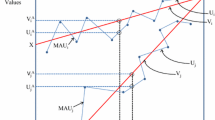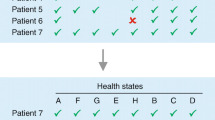Abstract
Objectives
(i) to demonstrate a method which ameliorates the problem of self-selection in the estimation of population norms from web-based data and (ii) to use the method to calculate population norms for two multi-attribute utility (MAU) instruments, the AQoL-6D and AQoL-8D, and population norms for the sub-scales from which they are constructed.
Methods
A web-based survey administered the AQoL-8D MAU instrument (which subsumes the AQoL-6D questionnaire), to members of the public along with the AQoL-4D which has extant population norms. Age, gender and the AQoL-4D were used as post-stratification auxiliary variables to construct weights to ameliorate the potential effects of self-selection associated with web-based surveys. The weights were used to estimate unbiased population norms. Standard errors from the weighted samples were calculated using Jackknife estimation.
Results
For both AQoL-6D and AQoL-8D, physical health dimensions decline significantly with age. In contrast, for the majority of the psycho-social dimensions there is a significant U-shaped profile. The net effect is a shallow U-shaped relationship between age and both the AQoL-6D and AQoL-8D utilities. This contrasts with the almost monotonic decline in the utilities derived from the AQoL-4D and SF-6D MAU instruments.
Conclusions
Post-stratification weights were used to ameliorate potential bias in the derivation of norms from web-based data for the AQoL-6D and AQoL-8D. The methods may be used generally to obtain norms when suitable auxiliary variables are available. The inclusion of an enlarged psycho-social component in the two instruments significantly alters the demographic profile.


Source: 2(a) to 2(j) Appendix 2 in ESM


Similar content being viewed by others
References
Simmons, C. A., & Lehmann, P. (2013). Tools for strengths-based assessment and evaluation. New York: Springer.
Bowling, A. (2005). Measuring health: A review of quality of life measurement scales (3rd ed.). Maidenhead, Berkshire: Open University Press.
McDowell, I. (2006). Measuring health: A guide to rating scales and questionnaires. Oxford: Oxford University Press.
Brazier, J., Ratcliffe, J., Salomon, J., & Tsuchiya, A. (2007). Measuring and valuing health benefits for economic evaluation. Oxford: Oxford University Press.
Richardson, J., McKie, J., & Bariola, E. (2014). Multi attribute utility instruments and their use. In A. J. Culyer (Ed.), Encyclopedia of health economics (pp. 341–357). San Diego: Elsevier Science.
EuroQol Group. (1990). EuroQol—a new facility for the measurement of health-related quality of life. Health Policy, 16, 199–208.
Dolan, P., Gudex, C., Kind, P., Williams, A. (1995). A social tariff for EuroQoL: Results from a UK general population survey. Discussion Paper No 138. York: Centre for Health Economics, University of York.
Torrance, G., Feeny, D., Furlong, W., Barr, R., Zhang, Y., & Wang, Q. (1996). Multiattribute utility function for a comprehensive health status classification system: Health utilities index mark II. Medical Care, 34(7), 702–722.
Feeny, D., Furlong, W., Torrance, G., Goldsmith, C., Zhu, Z., DePauw, S., et al. (2002). Multi attribute and single attribute utility functions for the health utilities index mark 3 system. Medical Care, 40(2), 113–128.
Brazier, J., Roberts, J., & Deverill, M. (2002). The estimation of a preference-based measure of health from the SF-36. Journal of Health Economics, 21, 271–292.
Brazier, J., Roberts, J., Tsuchiya, A., & Busschbach, J. (2004). A comparison of the EQ-5D and SF-6D across seven patient groups. Health Economics, 13, 873–884.
Sintonen, H., & Pekurinen, M. (1989). A generic 15 dimensional measure of health-related quality of life (15D). Journal of Social Medicine, 26, 85–96.
Hawthorne, G., Richardson, J., & Osborne, R. (1999). The Assessment of Quality of Life (AQoL) instrument: A psychometric measure of health related quality of life. Quality of Life Research, 8, 209–224.
Kaplan, R., Bush, J., & Berry, C. (1976). Health status: Types of validity and the index of wellbeing. Health Services Research, 11(4), 478–507.
Misajon, R., Hawthorne, G., Richardson, J., Barton, J., Peacock, S., Iezzi, A., & Keeffe, J. (2005). Vision and quality of life: The development of a utility measure. Investigative Ophthalmology and Visual Science, 46(11), 4007–4015.
Richardson, J., Iezzi, A., Peacock, S., Sinha, K., Misajon, R., & Keeffe, J. (2012). Utility weights for the vision related Assessment of Quality of Life (AQoL) 7D instrument. Ophthalmic Epidemiology, 19(3), 172–182.
Richardson, J., Elsworth, G., Iezzi, A., Khan, M. A., Mihalopoulos, C., Schweitzer, I., Herrman, H. (2011). Increasing the sensitivity of the AQoL inventory for evaluation of interventions affecting mental health. Research Paper 61. Melbourne: Centre for Health Economics, Monash University.
Richardson, J., Sinah, K., Iezzi, A., Khan, M. A. (2014). Modelling utility weights for the Assessment of Quality of Life (AQoL)-8D. Quality of Life Research, 23, 2395–2404.
Chen, G., Khan, M. A., Iezzi, A., Ratcliffe, J., & Richardson, J. (2016). Mapping between 6 multi attribute utility instruments. Medical Decsion Making, 36(2), 160–175.
Richardson, J., Khan, M. A., Iezzi, A., Maxwell, A. (2015). Measuring the sensitivity and construct validity of six utility instruments in seven disease states. Medical Decision Making, Accepted 22 Sep 2015.
Richardson, J., Khan, M. A., Iezzi, A., & Maxwell, A. (2015). Comparing and explaining differences in the content, sensitivity and magnitude of incremental utilities predicted by the EQ-5D, SF-6D, HUI 3, 15D, QWB and AQoL-8D multi attribute utility instruments’. Medical Decision Making, 35(3), 276–291.
Richardson, J., Chen, G., Khan, M. A., & Iezzi, A. (2015). Can multi attribute utility instruments adequately account for subjective well-being? Medical Decision Making, 35(3), 292–304. doi:10.1177/0272989X14567354
Campbell, J. A., Palmer, A. J., Venn, A., Sharman, M., Otahal, P., Neil, A. (2016). A head-to-head comparison of the EQ-5D-5L and AQoL-8D multi-attribute utility instruments in patients who have previously undergone bariatric surgery. The Patient—Patient-Centered Outcomes Research, 2016 1–12. doi:10.1007/s40271-015-0157-5
Hawthorne, G., Osborne, R., Sansoni, J., & Taylor, A. (2007). The SF-36 version 2: critical analysis of population weights, scoring algorithms and population norms. Quality of Life Research, 16(4), 661–673.
ABS. (1995). Austalian Bureau of Statistics, National Health Survey SF-36 Population Norms Australia ABS Catalogue No. 4399. Canberra: http://www.abs.gov.au/AUSSTATS/abs@.nsf/DetailsPage/4399.01995?OpenDocument. Accessed 19 Apr 2012.
Slade, T., Johnston, A., Oakley Brown, M. A., Adnrews, G., & Whitefor, H. (2009). National survey of mental health and wellbeing: Methods and key findings. Australian and New Zealand Journal of Psychiatry, 43(7), 594–605.
Hawthorne, G., Herrman, H., & Murphy, B. (2006). Interpreting the WHOQoL-Brèf: Preliminary population norms and effect size. Social Indicators Research, 77, 37–59.
Cummins, R. A., Knapp, T. M., Woerner, J., Walter, J., Page, K. (2005). The personal Wellbeing of Australians living within federal electoral divisions. Report No: 13.1. Melbourne: Deakin University.
Norman, R., Church, J., van den Berg, B., & Goodall, S. (2013). Australian health-related quality of life population norms derived from the SF-6D. Australian and New Zealand Journal of Public Health, 37(1), 17–23.
Hawthorne, G., Korn, S., & Richardson, J. (2013). Population norms for the AQoL derived from the 2007 Australian National Survey of Mental Health and Wellbeing. Australian and New Zealand Journal of Public Health, 37(1), 17–23.
Hawthorne, G., & Osborne, R. (2005). Population norms and meaningful differences for the Assessment of Quality of Life (AQoL) measure. Australian and New Zealand Journal of Public Health, 29(2), 136–142.
ABS. (2013). Australian demographic statistics, population by age and sex, Cat 3201.0. Canberra: Australian Bureau of Statistics http://www.abs.gov.au/AUSSTATS/abs@.nsf/DetailsPage/3201.0Jun%202010?OpenDocument. Accessed 12 Aug 2013.
Richardson, J., Iezzi, A., Khan, M. A., Chen, G. (2014). Interim population norms for the AQoL-6D and AQoL-8D multi attribute utility instruments. Research Paper 87. Melbourne: Centre for Health Economics, Monash University.
Meade, A. W., & Craig, B. S. (2012). Identifying careless responses in survey data. Psychological Methods, 17(3), 437–455.
Gatz, D. F., & Smith, L. (1995). The standard error of a weighted mean concentration-I: Bootstrapping vs other methods. Atmospheric Environment, 29(11), 1185–1193.
AQoL. (2016) Assessment of Quality of Life (AQoL). http://www.aqol.com.au.
Hawthorne, G. (2009). Assessing utility where short measures are required: Development of the short assessment of quality of life-8 (AQoL-8) instrument. Value in Health, 12(6), 948–957.
Frijters, P., & Beatton, T. (2012). The mystery of the U-shaped relationship between happiness and age. Journal of Economic Behavior and Organization, 82, 525–542.
Richardson, J., Iezzi, A., & Khan, M. A. (2015). Why do multi attribute utility instruments produce different utilities: The relative importance of the descriptive systems, scale and ‘micro utility’ effects. Quality of Life Research. doi:10.1007/s11136-015-0926-6.
Iezzi, A., & Richardson, J. (2016). A comparison of AQoL-4D, AQoL-6D, AQoL-7D and AQoL-8D multi attribute utility instruments. Research Paper 93. Melbourne: Centre for Health Economics, Monash University.
Acknowledgments
This research was funded by a National Health and Medical Research Council Project Grant ID: 1006334.
Author information
Authors and Affiliations
Corresponding author
Ethics declarations
Compliance with ethical standards
The research has been approved by the Monash University Human Research Ethics Committee Approval ID: CF15/2829-2015001164.
Conflict of interest
The authors declare that they have no conflict of interest.
Funding
This research was funded by National Health and Medical Research Council Project Grant ID: 1006334.
Electronic supplementary material
Below is the link to the electronic supplementary material.
Rights and permissions
About this article
Cite this article
Maxwell, A., Özmen, M., Iezzi, A. et al. Deriving population norms for the AQoL-6D and AQoL-8D multi-attribute utility instruments from web-based data. Qual Life Res 25, 3209–3219 (2016). https://doi.org/10.1007/s11136-016-1337-z
Accepted:
Published:
Issue Date:
DOI: https://doi.org/10.1007/s11136-016-1337-z




